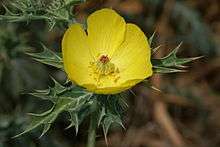Argemone mexicana
| Argemone mexicana | |
|---|---|
 | |
| Scientific classification | |
| Kingdom: | Plantae |
| (unranked): | Angiosperms |
| (unranked): | Eudicots |
| Order: | Ranunculales |
| Family: | Papaveraceae |
| Genus: | Argemone |
| Species: | A. mexicana |
| Binomial name | |
| Argemone mexicana L. | |


Argemone mexicana (Mexican poppy,[1] Mexican prickly poppy, flowering thistle,[2] cardo or cardosanto) is a species of poppy found in Mexico and now widely naturalized in many parts of the world. An extremely hardy pioneer plant, it is tolerant of drought and poor soil, often being the only cover on new road cuttings or verges. It has bright yellow latex, and though poisonous to grazing animals, is rarely eaten, but has been used medicinally by many people including those in its native area, the Natives of the western US and parts of Mexico.[3]
Chemical constituents
A. mexicana seeds contain 22–36% of a pale yellow non-edible oil, called argemone oil or katkar oil, which contains the toxic alkaloids sanguinarine and dihydrosanguinarine. Four quaternary isoquinoline alkaloids, dehydrocorydalmine, jatrorrhizine, columbamine, and oxyberberine, have been isolated from the whole plant of Argemone mexicana.[4]
The seed pods secrete a pale yellow latex when cut open. This argemone resin contains berberine and protopine.
Toxicity
The seeds resemble the seeds of Brassica nigra (mustard). As a result, mustard can be adulterated by argemone seeds, rendering it poisonous. Several significant instances of katkar poisoning have been reported in India, Fiji, South Africa and other countries. The last major outbreak in India occurred in 1998. 1% adulteration of mustard oil by argemone oil has been shown to cause clinical disease.[5] in India, Argemone oil is mixed with sunflower oil and sesame oil to increase the quantity, but this adulteration causes health disorders and renowned brands display "no argemone oil" to qualify purity.[6]
Katkar oil poisoning causes epidemic dropsy, with symptoms including extreme swelling, particularly of the legs.
Traditional medicine
The Seri of Sonora, Mexico use the entire plant both fresh and dried. An infusion is made to relieve kidney pain, to help expel a torn placenta, and in general to help cleanse the body after parturition.[3]
When the Spanish arrived in Sonora they added this plant to their pharmacopia and called it cardosanto, which should not be mistranslated to blessed thistle (Cnicus benedictus). The seeds are taken as a laxative.[7]
An Argemone mexicana tea is used by traditional healers in Mali to treat malaria. The whole plant is used to make a tea and as much tea as possible is drunk until symptoms disappear.[8] This use has been studied clinically for the treatment of uncomplicated malaria.[9][10] In one study, 73% of patients treated had an adequate clinical response, but very few patients had complete parasite clearance.[11] Another study found that use of Argemone mexicana may be a suitable first-aid treatment in rural areas when access to other better antimalarials is delayed.[12]
Other uses
Biodiesel production from A. mexicana seed oil using crystalline manganese carbonate has been demonstrated.
References
- ↑ "BSBI List 2007" (xls). Botanical Society of Britain and Ireland. Archived from the original on 2015-02-25. Retrieved 2014-10-17.
- ↑ Thomas C. Fuller (1986). Poisonous plants of California. University of California Press. pp. 201–. ISBN 978-0-520-05569-8. Retrieved 21 April 2013.
- 1 2 Felger, R. S.; Moser, M. B. (1985). People of the Desert and Sea. Tucson, AZ: University of Arizona Press.
- ↑ Singh, S.; Singh, T. D.; Singh, V. P.; Pandey, V. B. (February 2010). "Quaternary Alkaloids of Argemone mexicana". Pharmaceutical Biology. 48 (2): 158–160. doi:10.3109/13880200903062622. PMID 20645832.
- ↑ "Epidemic dropsy". WHO South East Asia Regional Office. Archived from the original on August 21, 2006. Retrieved 2006-11-17.
- ↑ "What is argemone oil?". The Times of India. The Times of India. 31 August 2008. Retrieved 3 July 2016.
- ↑ Moore, M. (1990). Los Remedios: Traditional Herbal Remedies of the Southwest. Santa Fe, NM: Museum of New Mexico Press.
- ↑ Willcox, M. L.; Graz, B.; Falquet, J.; et al. (2007). "Argemone mexicana Decoction for the Treatment of Uncomplicated Falciparum Malaria". Transactions of the Royal Society of Tropical Medicine and Hygiene. 101 (12): 1190–1198. doi:10.1016/j.trstmh.2007.05.017. PMID 17920092.
- ↑ Merlin L Willco; Bertrand Graz; Jacques Falquet; Chiaka Diakite; Sergio Giani; Drissa Diallo (2011). "A "reverse pharmacology" approach for developing an anti-malarial phytomedicine". Malaria Journal. 10 (Suppl 1): S8. doi:10.1186/1475-2875-10-S1-S8.
- ↑ "Drug Developers Take a Second Look at Herbal Medicines". Scientific American. 2014-01-06. (subscription required (help)).
- ↑ Merlin L. Willcox; Bertrand Graz; Jacques Falquet; Oumar Sidibé; Mathieu Forster; Drissa Diallo (2007). "Argemone mexicana decoction for the treatment of uncomplicated falciparum malaria". Trans R Soc Trop Med Hyg. 101 (12): 1190–1198. doi:10.1016/j.trstmh.2007.05.017.
- ↑ Bertrand Graza; Merlin L. Willcoxa; Chiaka Diakiteb; Jacques Falqueta; Florent Dackuo; Oumar Sidibe; Sergio Giani; Drissa Diallo (2010). "Argemone mexicana decoction versus artesunate-amodiaquine for the management of malaria in Mali: Policy and public-health implications". Trans R Soc Trop Med Hyg. 104 (1): 33–41. doi:10.1016/j.trstmh.2009.07.005.
External links
- Dressler, S.; Schmidt, M. & Zizka, G. (2014). [http://www.africanplants.senckenberg.de/root/index.php?submitForm=true&page_id=77&searchTextMenue=Argemone+mexicana&filterRegionIDs[]=6&filterRegionIDs[]=1&filterRegionIDs[]=2&filterRegionIDs[]=3&filterRegionIDs[]=5 "Argemone mexicana"]. African plants – a Photo Guide. Frankfurt/Main: Forschungsinstitut Senckenberg.